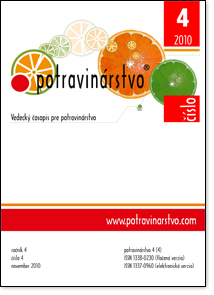Effect of moderate red wine consumption on the development and progression of metabolic syndrome as a complex risk factor for cardiovascular disease and diabetes mellitus II.
DOI:
https://doi.org/10.5219/91Keywords:
metabolic syndrome, cardiovascular disease, HDL-cholesterol, LDL-cholesterol, triglycerides, blood pressure, glucose, WHR.Abstract
Metabolic syndrome is characterized by a set of clinical symptoms that are related to the development of cardiovascular disease. These abdominal obesity, which is the strongest associate with the metabolic syndrome and clinically manifested increasing waist circumference and ratio of waist to hip, atherogenic dyslipidaemia, which is reflected in the routine diagnosis of increased levels of triglycerides and reduced levels of HDL-cholesterol, high blood pressure, insulin resistance and/or various forms of glucose intolerance, proinflammatory and prothrombotic state. Epidemiological, experimental and clinical investigations have shown that diets supplemented with moderate quantities of alcoholic beverages lead to biochemical changes, that are widely regarded to prevent cardiovascular diseases. Red wine contains a naturally rich sources of antioxidants which may protect the body from oxidative stress. We investigated the relationship between red wine intake and lipide profile, glucose, blood pressure and WHR index changes. Participants consumed 200 ml of red wine Frankovka modra (VÍNO-MASARYK, s.r.o., Skalica) each day during supper for six weeks and were encouraged to maintain their usual diet and exercise habits. Daily intake of Frankovka modra during six weeks was associated with lower plasma levels of total cholesterol (5.66±1.12 vs 5.36±1.04), triglycerides (1.68±0.23 vs 1.47±0.66), LDL-cholesterol (3.46±0.81 vs 3.26±0.76) and glucose (5.35±0.82 vs 5.26±0.78). On the contrary we recorded higher level of „good“ HDL cholesterol (1.42±0.63 vs 1.80±0.58). Systolic and diastolic blood pressure was also decreased and diastolic blood pressure after six weeks of consumption of red wine decreased statistically significantly. Research results have shown that moderate consumption of red wine have a positive impact on changes waist and ultimately to the Waist to Hip Ratio. Our study demonstrates a positive association between moderate wine consumption and risk of cardiovascular disease and metabolic syndrome.
Downloads
Metrics
References
BASTIANETTO, S. 2002. Red wine consumption and brain aging. In Nutrition, vol. 18, 2002, no. 4, p. 432-433. DOI: https://doi.org/10.1016/S0899-9007(01)00745-6
PMID: 11985952
CASTELLI, W.P., GARRISON, R.J., WILSON, P.W., ABBOTT, R.D., KALOUSDIAN, S. KANNEL, W.B. 1986. Incidence of coronary heart disease and lipoprotein cholesterol levels. The Framingham Study. In JAMA, 1986, 256(20): 2835-2838. DOI: https://doi.org/10.1001/jama.256.20.2835
PMID: 3773200
GORDON, D.J., PROBSTFIELD, J.L., GARRISON, R.J., NEATON, J.D., CASTELLI, W.P., KNOKE, J.D., JACOBS, D.R., BANGDIWALA, S., TYROLER, H.A. 1989. High-density lipoprotein and cardiovascular disease. Four prospective American Studies. In Circulation, vol. 79, 1989, p. 8-15. DOI: https://doi.org/10.1161/01.CIR.79.1.8
PMid:2642759
JELSKI, W., SZMITKOWSKI, M. 2007. Effect of ethanol on metabolic syndrome. In Pol. Arch. Med. Wewn., vol. 117, 2007, no. 7, p. 306-311. DOI: https://doi.org/10.20452/pamw.164
PMID: 17966596
JOOSTEN, M.M., BEULENS, J.W.J., KERSTEN, S., HENDRIKS, H.F.J. 2008. Moderate alcohol consumption increases insulin sensitivity and ADIPOQ expression in postmenopausal women: a randomised, crossover trial. In Diabetologia, 2008, no. 51, p. 1375 – 1381.
https://doi.org/10.1007/s00125-008-1031-y DOI: https://doi.org/10.1007/s00125-008-1031-y
JURKOVIČOVÁ, J. 2005. Vieme zdravo žiť? Bratislava: Univerzita Komenského v Bratislave, 2005. 166 s. ISBN 80-223-2132-X.
KREZE, A. – LANGER, P. – KLIMEŠ, I. – STÁRKA, L. – PAYER, J. – MICHÁLEK, J. 2004. Všeobecná a klinická endokrinológia. Bratislava: Academic Electronic Press, 2005. 896 s. ISBN 80–88880–58–0.
MANNINEN V., ELO M.O., FRICK M.H., HAAPA K., HEINONEN O.P., HEINSALMI P., HELO P., HUTTUNEN J.K., KAITANIEMI P., KOSKINEN P., MÄENPÄÄ H., MÄLKÖNEN M., MÄNTTÄRI M., NOROLA S., PASTERNACK A., PIKKARAINEN J., ROMO M., SJÖBLOM T., NIKKILÄ E.A. 1998. Lipid alterations and decline in the incidence of coronary heart disease in the Helsinki Heart Study. In JAMA, vol. 260, 1998, no. 5, p. 641-651.
PMID: 3164788
MANSON, J.E., WILLET, W.C., STAMPFER, M.J., COLDITZ, G.A., HUNTER, D.J., HANKINSON, S.E., HENNEKENS, C.H., SPEIZER, F.E. 1995. Body weight and mortality among women. In New England Journal of Medicine, 1995, 333: 677-685.
https://doi.org/10.1056/NEJM199509143331101 DOI: https://doi.org/10.1056/NEJM199509143331101
MILLER, M., SEIDLER, A., KWITEROVICH, J.R., PEARSON, T.A. 1992. Long Term predictors of subsequent cardiovascular events with coronary artery disease and „desirable“ levels of plasma total cholesterol. In Circulation, 1992, vol. 86, p. 1165-1170. DOI: https://doi.org/10.1161/01.CIR.86.4.1165
PMID: 1394924
SLEZÁK, F. 2003. Víno a zdravie. In Vinič a víno, roč. 3, 2003, č. 1, s. 19-20. ISSN 1335-7514.
STAMPFER, M., KANG, J. H., CHEN, J., CHERRY, R., GRODSTEIN, F. 2005. Effects of Moderate Alcohol Consumption on Cognitive Function in Women. In Engl. J. Med., 2005, p. 352-353. DOI: https://doi.org/10.1056/NEJMoa041152
PMID: 15659724
ŠAMÁNEK, M. – URBANOVÁ, Z. 2003. Pít či nepít? Praha: Radix, 2003. 68 s. ISBN 80-86031-46-2.
Third report of the National Cholesterol Education Program (NCEP) expert panel on detection, evaluation, and treatment of high blood cholesterol in adults (Adult Treatment Panel III). Final report. 2002. In Circulation, 2002, 106: 3143-3421. DOI: https://doi.org/10.1161/circ.106.25.3143
PMID: 12485966
ZANCHETTI, A., HANSSON, L., CLEMENT, D., ELMFELDT, D., JULIUS, S., ROSENTHAL, T., WAEBER, B., WEDEL, H. 2003. Benefits and risks of more intensive blood pressure lowering in hypertensive patients of the HOT Study with different risk profiles: does a J-shaped curve exist in smokers? In Journal of Hypertension, 2003, 21:797-804
https://doi.org/10.1097/00004872-200304000-00024 DOI: https://doi.org/10.1097/00004872-200304000-00024
Downloads
Published
How to Cite
Issue
Section
License
This license permits non-commercial re-use, distribution, and reproduction in any medium, provided the original work is properly cited, and is not altered, transformed, or built upon in any way.






























